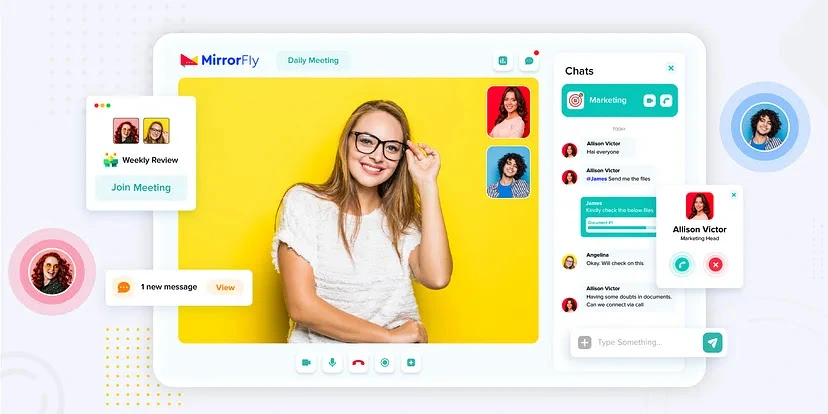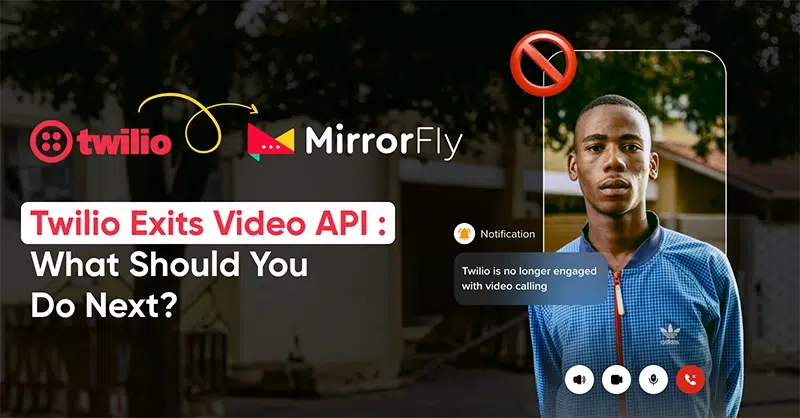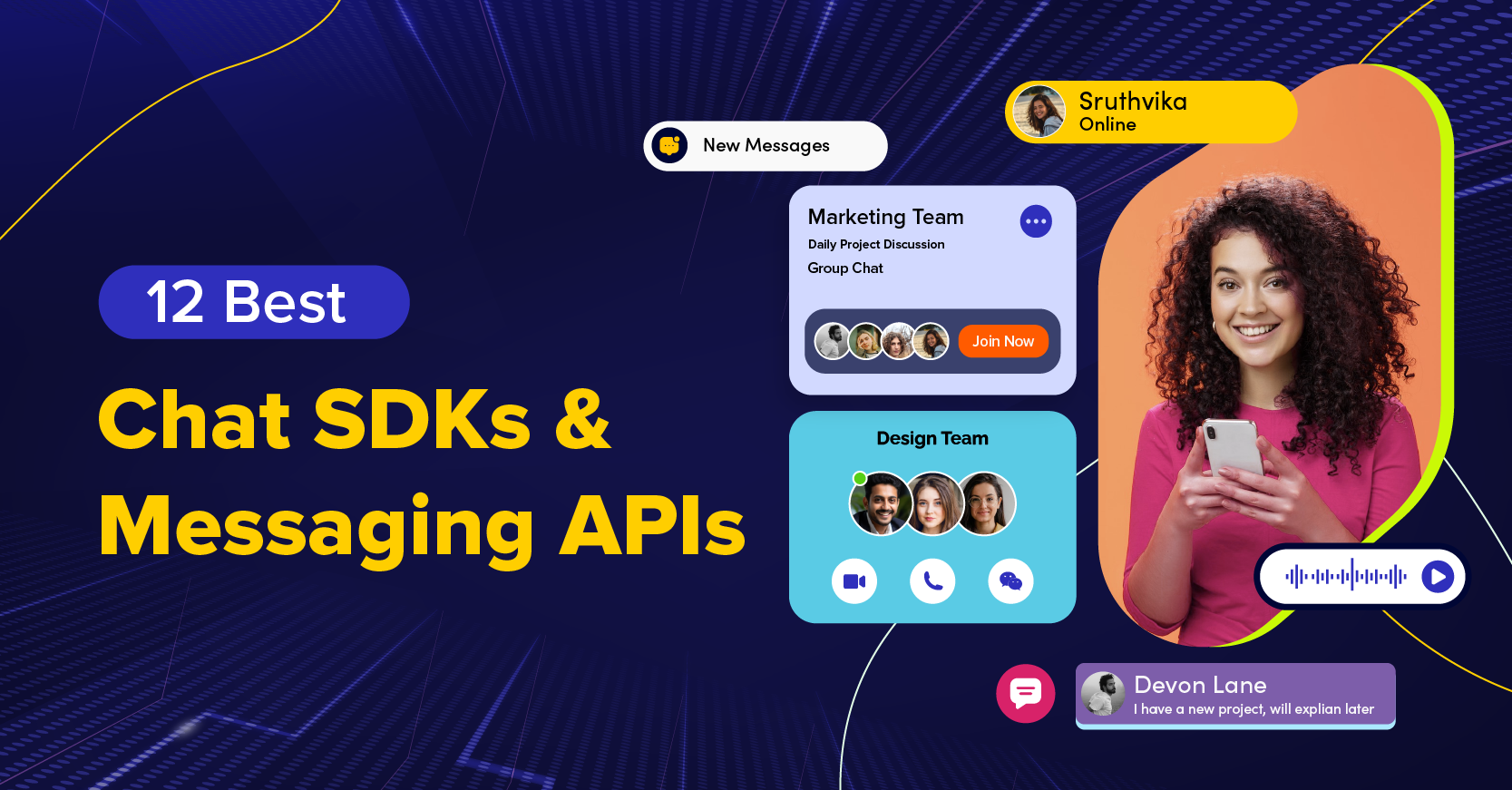WebRTC Group Video Call Solution – Guide for Developers
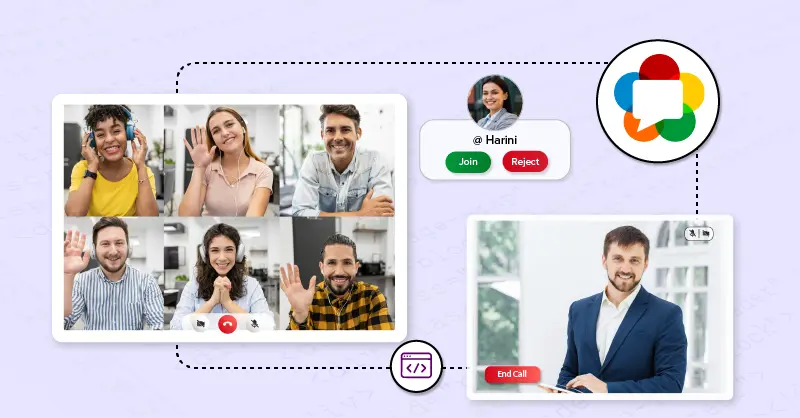
WebRTC (Web Real-Time Communication) is the game changing technology across the digital communication world.
The concept of WebRTC has transformed how we think and approach video and voice chat over the web with its free and open-source platform capabilities.
WebRTC enables real-time peer-to-peer communication with the help of simple video APIs.
Developers can directly embed video and voice communication capabilities into web and mobile applications without any complex process.
In this guide, let’s understand how the WebRTC video call technology will transform real-time communication, how it works, and its applications in business fields.
Table of Contents
WebRTC Video Call – The Detailed Explanation
WebRTC platform was introduced in May 2011 by Google as an open-source platform. The first browser-to-browser call was made in February 2013.
Back from there, WebRTC remains a stable chat technology utilizing a combination of codecs, network protocols and encryption for secure communication.
The two main components of WebRTC signaling includes:
- Media Channels: These channels are responsible for transferring audio and video data between peers to experience real-time communication using codecs such as VP8, VP9 and H.264.
- Data Channels: They are responsible for transferring and exchanging arbitrary data between peers, such as text, files and game data. The data channels are built on top of the SCTP protocol for reliable and unreliable data transfer.
With WebRTC API, the possibilities for creating ultimate web and mobile applications are endless.
The development capabilities include video conferencing platforms, voice and video calling applications, live streaming, whiteboards, gaming platforms with voice and chat, and customer support systems for call centers.
How WebRTC Works – The Overview & Server Architecture
Basically, WebRTC was designed as a Peer-to-peer protocol. This explains that there are always two people connected through single WebRTC connections.
Let’s understand the WebRTC servers and the high-level overview first to learn all about the audio and video call capabilities.
The Server Architecture of WebRTC
1. Signaling Server
The signaling server in WebRTC is responsible for establishing connections between two peers, such as IP address and session descriptions.
This server heads up to set up, control and terminate a WebRTC call.
The main purpose of the signaling service is to initiate a call. After that is done, WebRTC will take over. But it doesn’t mean signaling is not required after the call is initiated.
It’s mandatory to establish a reconnection if any peer in the call runs out of network connection.
2. Mesh Architecture
In the Mesh architecture, every peer is connected to every other peer in the call. For instance, in a 4-peer call, every peer has to share their video with the other 3 peers and receive from the same.
Expecting a limited number of users in the WebRTC calls can consider this architecture while creating WebRTC video call applications.
3. Session Traversal Utility for NAT (STUN)
STUN server employs to get the public IP of a device behind NAT (Network Address Translation). STUN allows communication after learning addresses on the internet.
4. Traversal Using Relay NAT (TURN)
The TURN server is also called the “relay server”, as it relays the media throughout the WebRTC connection.
The TURN server often comes in charge when a direct connection is not possible due to Symmetric NAT or firewall-blocking connections.
5. WebRTC Media Servers
With WebRTC media, peers send their media to and receive processed media from. These often act as central servers and offer various other benefits, too.
However, implementing this one from scratch isn’t easy compared to building with WebRTC video API.
These all are the basic servers in WebRTC with the simple view of the communication process.
The other establishment of WebRTC server include
- Mixing Architecture Using MCU
- Routing Architecture Using SFU
The High-Level Workflow of WebRTC Video Calling
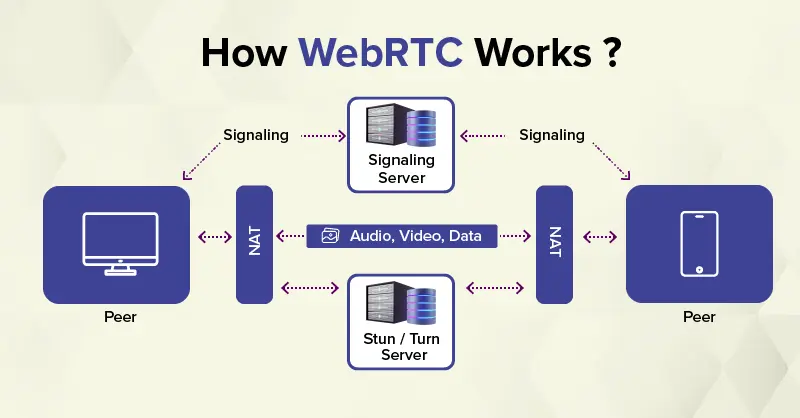
1. Signaling
As mentioned above, before two peers establish a WebRTC connection, the Signaling server acts as an intermediary between the two peers to exchange information on IP addresses and session descriptions.
2. Peer Connection
After the signaling server completes its work, users can establish peer connections. This allows peers to exchange data such as audio and video directly without going through a server.
3. Media Capture & Processing
Before the data (audio and video) between the peers needs to be exchanged, it should be captured from the devices. WebRTC APIs collect and capture audio and video directly from the microphones and the device’s cam.
Then, it’ll be converted into a codec, and this encoded media will be sent over the peer connection.
4. Media Rendering
Once the other peer receives the transferred media, it needs to be decoded and rendered. WebRTC APIs will help render those media files on the received peer device.
Is WebRTC Secure?
Is WebRTC video calls secure for both personal and business communications?
In short, yes. WebRTC is secure. But if you expect the long answer, WebRTC is well-secured for end users but a nightmare for developers.
Here’s the instance: if the WebRTC connection bypasses the end user’s firewall, VPN or NAT, the data will be safe and encrypted by WebRTC protocol layer encryption.
Since WebRTC is built for high-level security, it’s not automatically 100% secured. It has both limitations and vulnerabilities that need to be addressed and evaluated by WebRTC providers.
- Encryption
WebRTC API for video and voice calls uses end-to-end encryption, as mentioned above. However, when establishing the connection between peers or devices, developers have to handle signaling separately.
Using secure signaling like HTTPS and using seamless authentication will make it safer.
- User Privacy
Nowadays, browsers request permission to turn on the microphone and camera before proceeding with the call. Developers or WebRTC service providers should always ensure this consent throughout the entire communication lifecycle.
- Deployment & Management
Deploying WebRTC applications involves significant considerations like servers, policies, secure WebSocket and HTTPS.
No matter, if you develop an application from a mobile app development company or use WebRTC SDK, doing regular security audits and applying consistent updates and security patches, are crucial.
Recommended Reading
Application of WebRTC in Business Communications
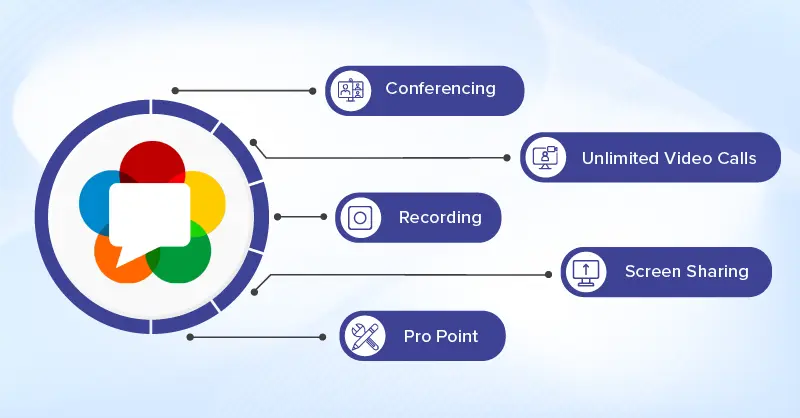
WebRTC Video Call
Whether it’s for internal communication or client meetings, incorporating WebRTC video calls will improve productivity and collaboration in the workplace. Not just limited with video call, the features of WebRTC in business environment includes
- Calling: To join a team or share insights with all the organizations, with WebRTC, it’s easy to create video conferencing.
- Unlimited Group Calls & Improved Video: As followed by video conferencing, with WebRTC, creating text and audio calls even with AI is possible. Despite the geographical boundaries, people can interact easily using WebRTC.
- Recording: As one of the foremost advantages of WebRTC, recording audio and video calls and transcripts later will be the best features for businesses.
- Screen Sharing: This feature in WebRTC conference video call enables users to share their screen for presentations, solving complex problems and for many cases.
- Pro Point: Building white-label WebRTC video conferencing app for business communication will let you customize the look and features that align with your brand value.
As a result, the team or the client will follow your brand principles even in remote connections. Moreover, the development time and cost are lower, and the features are vast.
WebRTC Video Calling App in Call Centers
Since WebRTC has offered a seamless shift between communication channels, call center businesses can provide more efficient and cost-effective communication channels to customers.
At any point such as email or web chatbot interaction, an agent can make a WebRTC call and send it to the customer to join in a live voice or video call.
Again, it’s much easier to reflect business branding in the call app with the self-hosted WebRTC solutions.
For Recruitment Process
WebRTC, with a white-label solution, will be an excellent option for recruitment companies as it accompanies both synchronous and asynchronous video interview models.
With the increase in remote models, it’s now great to build a WebRTC video app that will support both internal communication and the virtual hiring tracking process.
How White-Label WebRTC Video Calling Will Make the Difference?
You must be wondering what the white-label WebRTC app is that you went through the many pro points throughout the article. Let us explain that.
White-label WebRTC group video calling API and SDKs are pre-built solutions with all the WebRTC capabilities with unlimited customizations and features.
The integration of ready-made solutions will enable full flexibility over branding, audio and video conferencing, hosting and scalability.
You can experience all the unlimited capabilities, such as audio and video calls, group conferencing, concurrent users, and other features.
Here we list the best WebRTC service providers based on their capabilities in real-time: MirrorFly, ApphiTect, Dyte.io, Twilio, Agora, and more.
Final Thoughts
Hope you explored the powerful features of WebRTC for building real-time communication for business environments. Keep in mind that the integration determines the security wall for your video conferencing software.
Moreover, WebRTC will continue to shape online communication, and its versatile capabilities will enable us to build many collaborative tools and business instant messaging solutions.

